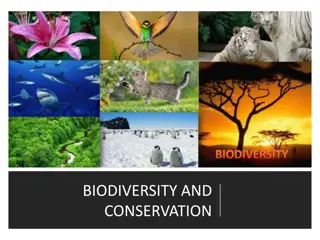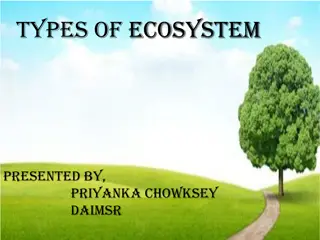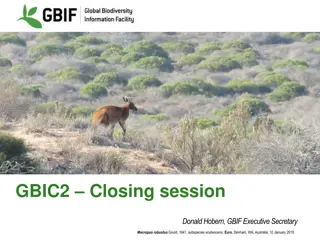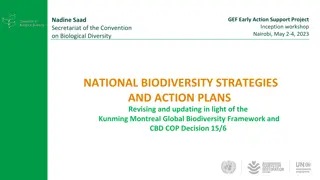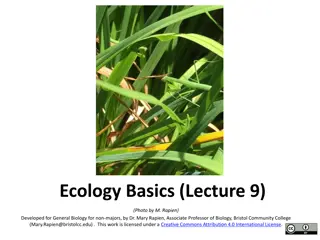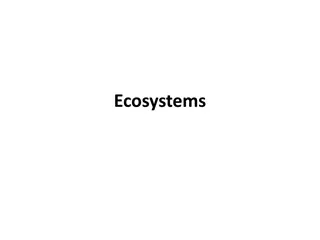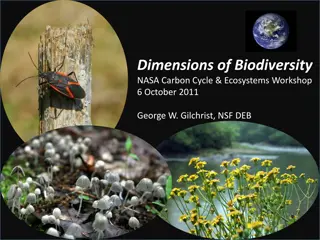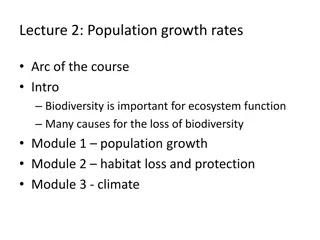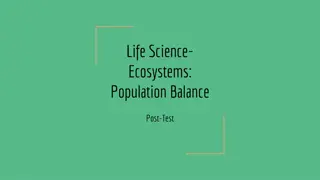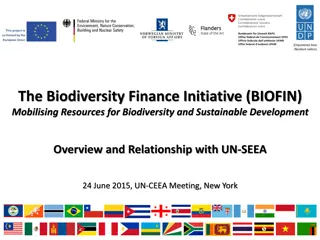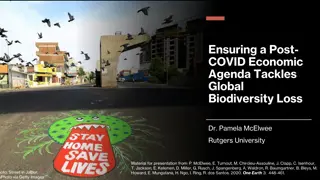The Significance of Biodiversity in Ecosystems
Biodiversity plays a crucial role in boosting ecosystem productivity by ensuring each species contributes uniquely. Measuring biodiversity involves counting species in an area, with a higher species diversity indicating greater biodiversity. Despite this importance, an alarming number of species go extinct daily due to human activities, emphasizing the need for conservation efforts to protect our planet's precious biodiversity.
Uploaded on Sep 24, 2024 | 0 Views
Download Presentation

Please find below an Image/Link to download the presentation.
The content on the website is provided AS IS for your information and personal use only. It may not be sold, licensed, or shared on other websites without obtaining consent from the author.If you encounter any issues during the download, it is possible that the publisher has removed the file from their server.
You are allowed to download the files provided on this website for personal or commercial use, subject to the condition that they are used lawfully. All files are the property of their respective owners.
The content on the website is provided AS IS for your information and personal use only. It may not be sold, licensed, or shared on other websites without obtaining consent from the author.
E N D
Presentation Transcript
In The Name Of God In The Name Of God Biodiversity Biodiversity Global Issues: Environment Learning Circle 1 (Middle/High School) Mehr Aein School Iran - Tehran
By: Amirali Karami Armin Amini Barad Kadivar Teacher: Ms. Mirkhosravi
What is biodiversity exactly? Biodiversity boosts ecosystem productivity where each species, no matter how small, all have an important role to play . For example, a larger number of plant species means a greater variety of crops; greater species diversity ensures natural sustainability for all life forms; and healthy ecosystems can better withstand and recover from a variety of disasters .And so, while we dominate this planet, we still need to preserve the diversity in wildlife.
How is biodiversity measured? Biodiversity is determined by counting the number of species occurring in a given unit of area. The greater the species diversity within an area, the higher the biodiversity, which can be calculated using various methods, such as diversity indices.
How many species go extinct every day? On average, we lose about 150 species a day that s around 55,000 every year! Many species will have become extinct due to human encroachment on their habitats long before we have discovered the true wealth of biodiversity we are destroying. The United Nations declared 2010 to be the International Year of Biodiversity to celebrate life on earth and underscore its precious nature. Once a species is lost, it is gone forever: we will never again be able to experience a Steller s sea cow a marine mammal related to the dugong and manatee. The sea cows were hunted to extinction by our ancestors in 1768 only 27 years after they were discovered by Europeans. The International Union for Conservation of Nature (IUCN) has listed many thousands of endangered animal and plant species from around the world in its Red List. The list is by no means complete, however.
Why is biodiversity so important and worthy of protection? Research has shown that biodiversity is an important factor for the properties and performance of ecosystems. Their stability depends in part on the complex interactions of their inhabitants. Massive human interference decimates individual species or drives them to extinction, while other existing species experience explosive growth, and yet others invade or are introduced by humans. This alters the nature of ecosystems or destroys them outright and impacts ecosystem services such as the provision of food and clean water.
Species depend on each other While there might be survival of the fittest within a given species, each species depends on the services provided by other species to ensure survival. It is a type of cooperation based on mutual survival and is often what a balanced ecosystem refers to. Soil, bacteria, plants; the Nitrogen Cycle The relationship between soil, plants, bacteria and other life is also referred to as the nitrogen cycle:
What alternative options are there for protecting biodiversity? Improved cultivation methods, suitable seed and agro-ecological strategies offer considerable potential to improve yields. Wherever there is enough land, water, money and equipment, smallholders produce a much higher nutritional yield per hectare than industrial agriculture and with a much lower environmental impact. Methods need to be adapted to local circumstances: optimized smallholder agriculture would be highly beneficial in some countries like India. By contrast, the seminomadic indigenous people that inhabit the great area of the Amazon basin would already benefit greatly from protection against the oil, tropical timber, gold and plantation industries.
How can we help promote biodiversity? Our contributions toward protecting biodiversity are limited only by your imagination. Anyone can raise awareness: explain the consequences of deforestation to your family, friends and acquaintances. Tell people about the threat of extinction and have more public discussion. Review your own lifestyle and consumption behavior. Avoid products that contain palm oil. With regard to wood, use products made of local rather than tropical timber. Support the birds, reptiles, mammals, and plants that live in your neighborhood. You can also attract more wild species by providing water, food, shelter, and privacy. Explore habitats in your area. Help clean up and protect beaches, parks, reserves, and fields where wild plants and animals live.
Coral Reefs One type of ecosystem that perhaps is neglected more than any other is perhaps also the richest in biodiversity the coral reefs. Coral reefs are useful to the environment and to people in a number of ways. However, all around the world, much of the world s marine biodiversity face threats from human and activities as well as natural. It is feared that very soon, many reefs could die off.
Addressing Biodiversity lost At the 1992 UN Conference on Environment and Development (the Earth Summit), the Convention on Biological Diversity (CBD) was born. 192 countries, plus the EU, are now Parties to that convention. In April 2002, the Parties to the Convention committed to significantly reduce the loss of biodiversity loss by 2010. Perhaps predictably, that did not happen. Despite numerous successful conservations measures supporting biodiversity, the 2010 biodiversity target has not been met at the global level.






